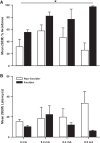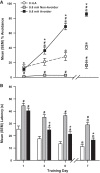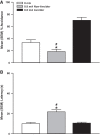Analysis of memory modulation by conditioned stimuli
- PMID: 33593927
- PMCID: PMC7888238
- DOI: 10.1101/lm.052407.120
Analysis of memory modulation by conditioned stimuli
Abstract
Conditioned stimuli (CS) have multiple psychological functions that can potentially contribute to their effect on memory formation. It is generally believed that CS-induced memory modulation is primarily due to conditioned emotional responses, however, well-learned CSs not only generate the appropriate behavioral and physiological reactions required to best respond to an upcoming unconditioned stimulus (US), but they also serve as signals that the US is about to occur. Therefore, it is possible that CSs can impact memory consolidation even when their ability to elicit conditioned emotional arousal is significantly reduced. To test this, male Sprague-Dawley rats trained on a signaled active avoidance task were divided into "Avoider" and "Non-Avoider" subgroups on the basis of percentage avoidance after 6 d of training. Subgroup differences in responding to the CS complex were maintained during a test carried out in the absence of the US. Moreover, the subgroups displayed significant differences in stress-induced analgesia (hot-plate test) immediately after this test, suggesting significant subgroup differences in conditioned emotionality. Importantly, using the spontaneous object recognition task, it was found that immediate post-sample exposure to the avoidance CS complex had a similar enhancing effect on object memory in the two subgroups. Therefore, to our knowledge, this is the first study to demonstrate that a significant conditioned emotional response is not necessary for the action of a predictive CS on modulation of memory consolidation.
© 2021 Lapointe et al.; Published by Cold Spring Harbor Laboratory Press.
Figures






Similar articles
-
Enhancement of memory consolidation by an avoidance conditioned stimulus: Modulation by the D3 receptor.Neuropharmacology. 2023 Sep 1;235:109572. doi: 10.1016/j.neuropharm.2023.109572. Epub 2023 May 4. Neuropharmacology. 2023. PMID: 37149214
-
Modulation of object memory consolidation by heroin and heroin-conditioned stimuli: Role of opioid and noradrenergic systems.Eur Neuropsychopharmacol. 2020 Apr;33:146-157. doi: 10.1016/j.euroneuro.2020.01.010. Epub 2020 Feb 14. Eur Neuropsychopharmacol. 2020. PMID: 32067860
-
Cocaine, nicotine, and their conditioned contexts enhance consolidation of object memory in rats.Learn Mem. 2019 Jan 16;26(2):46-55. doi: 10.1101/lm.048579.118. Print 2019 Feb. Learn Mem. 2019. PMID: 30651377 Free PMC article.
-
Applications and limitations of behaviorally conditioned immunopharmacological responses.Neurobiol Learn Mem. 2017 Jul;142(Pt A):91-98. doi: 10.1016/j.nlm.2017.02.012. Epub 2017 Feb 16. Neurobiol Learn Mem. 2017. PMID: 28216206 Review.
-
Histamine regulates memory consolidation.Neurobiol Learn Mem. 2017 Nov;145:1-6. doi: 10.1016/j.nlm.2017.08.007. Epub 2017 Aug 23. Neurobiol Learn Mem. 2017. PMID: 28838882 Review.
Cited by
-
The effects of passive and active administration of heroin, and associated conditioned stimuli, on consolidation of object memory.Sci Rep. 2022 Nov 27;12(1):20351. doi: 10.1038/s41598-022-24585-9. Sci Rep. 2022. PMID: 36437288 Free PMC article.
-
Memory persistence enhancement by post-learning moderate exercise requires de novo protein synthesis in the dorsal hippocampus.PLoS One. 2025 Jul 18;20(7):e0328128. doi: 10.1371/journal.pone.0328128. eCollection 2025. PLoS One. 2025. PMID: 40679969 Free PMC article.
-
Behavioral outputs and overlapping circuits between conditional fear and active avoidance.Neurobiol Learn Mem. 2024 Sep;213:107943. doi: 10.1016/j.nlm.2024.107943. Epub 2024 May 29. Neurobiol Learn Mem. 2024. PMID: 38821256 Free PMC article. Review.
-
A sex-specific role for the bed nucleus of the stria terminalis in proactive defensive behavior.Neuropsychopharmacology. 2023 Jul;48(8):1234-1244. doi: 10.1038/s41386-023-01581-9. Epub 2023 May 4. Neuropsychopharmacology. 2023. PMID: 37142666 Free PMC article.
References
-
- Antunes GF, Gouveia FV, Rezende FS, de Jesus Seno MD, de Carvalho MC, de Oliveira CC, dos Santos LCT, de Castro MC, Kuroki MA, Teixeira MJ, et al. 2020. Dopamine modulates individual differences in avoidance behavior: a pharmacological, immunohistochemical, neurochemical and volumetric investigation. Neurobiol Stress 12: 100219 10.1016/j.ynstr.2020.100219 - DOI - PMC - PubMed
-
- Balsam PD, Drew MR, Yang C. 2002. Timing at the start of associative learning. Learn Motiv 33: 141–155. 10.1006/lmot.2001.1104 - DOI
-
- Bolles RC, Fanselow MS. 1980. A perceptual-defensive-recuperative model of fear and pain. Behav Brain Sci 3: 291–301. 10.1017/S0140525X0000491X - DOI
Publication types
MeSH terms
LinkOut - more resources
Full Text Sources
Other Literature Sources
